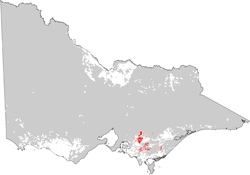Victorian Dairy Soils - Ferrosols
Back to: Victorian Dairy Soil
| Ferrosols are deep red friable soils that lack strong texture contrast between surface (A) horizons and the upper subsoil (B21) horizon. They have also previously been known as 'krasnozems'. These soils are characterised by relatively high levels of free iron oxide (i.e. free iron oxide content greater than 5%) and are generally strongly acid in the upper soil profile. Mainly Red Ferrosols have been described in Gippsland, but some Brown and Yellow forms occur. |  Example Ferrosol soil profile at Ellinbank in West Gippsland |
| Red Ferrosols are common in the West Gippsland dairying region, where they are associated with the rolling basalt (referred to by geologists as ‘Older Volcanic’) hills in the Warragul, Thorpdale, Leongatha and Neerim South areas. Soil pit site GP15 is an example of a Red Ferrosol at Ellinbank. These Red Ferrosols are generally strongly acidic throughout, lack strong texture contrast and are high in free iron oxide. Red Ferrosols occur also in smaller areas to the east of Ballarat in South West Victoria and in the King Valley area in the North East. |  |
| Ferrosols have high levels of free iron oxide which gives them a high degree of structural stability. Due to their high iron oxide contents these soils tend to "fix" phosphorus which makes it less available to plants. Regular phosphorus application will assist in overcoming such a deficiency. Addition of molybdenum may also be required. This can be assessed by plant tissue analysis of clover. Zinc and copper can also be 'fixed' by high iron oxide contents. These soils are deep and very well drained due to their strongly developed structure and lack of strong texture contrast between surface and subsoil horizons. Water infiltration rates will be high unless significant compaction has occurred. |  |
Plant Available Water Capacity (PAWC) is usually high on these soils as there are few restrictions to plant rooting depth and they have high clay content and organic matter levels in the upper profile. Due to their high clay content in surface horizons, however, the high wilting point can be quite high, indicating that plants will not be able to utilise light rains falling on relatively dry soil.
Soil compaction from trafficking, over-stocking or cultivation can lead to reduced water infiltration and retention as well as an increase in soil strength (resulting in mechanical resistance to roots) and cloddiness. These soils are more prone to compaction when the soil is wetter than the plastic limit. Ideally, tillage, trafficking and stocking should occur when the soil is drier than the plastic limit (at least within the top 40 cm from the surface or to the depth of cultivation). Compaction on soils such as these can be more serious on these soils than on cracking clay soils that tend to self-repair due to their strong shrink-swell capacity.
Red Ferrosols have a high pH buffering capacity (i.e. require a larger lime application to raise soil pH). Over-liming, however, may result in some micronutrient deficiencies and may result in reduced aggregate stability. As they are often strongly acid (at least in the upper soil profile) the level of exchangeable aluminium can become high which will restrict the growth of aluminium-sensitive species.
 | Red Ferrosols generally have high organic matter levels, which enhances soil fertility and aggregate stability. When intensively cropped, organic matter levels will decline and this will result in some structural degradation and fertility decline. Studies have shown that organic matter is an important source of nitrogen, phosphorus and sulphur in such soils. Management practices that result in increased organic matter levels include: minimum tillage; growing green manure crops (e.g. annual ryegrass, sorghum, oats, lupins); incorporating pasture phases in crop rotations, and retaining and incorporating crop residues (Cotching 1995). |
The subplastic properties of the subsoil can lead to problems with sealing of earth dams. Sealing of dams constructed on such soils can be achieved by compaction at the optimum water content and treatment with sodium tri-polyphosphate or addition of bentonite (Rolfe 1989).
Note: For an excellent review paper on management of Ferrosols refer to Cotching (1995). Also, the results of a study of land management effects on the structure of Ferrosols in this region has been presented by Hirst et al. (1992).
References
Cotching, B. (1995). Long term management of krasnozems in Australia. Aust. J. Soil and Water Cons. 8:1 (pp 18-27).
Coughlan, K.J; Fox, W.E. and Hughes, J.D. (1973). A study of the mechanisms of aggregation in a krasnozem soil. Aust. J. Soil Res. 11: 65-73.
Hirst, K.M; Imhof, M.P. and Weston, B.A. (1992). The effect of land management on the structure of intensively cropped soils in West Gippsland. Research Report series No. 138. Department of Agriculture.
Rolfe, L. (1989). Sealing earth dams in red krasnozems of the Lismore area. NSW Agriculture and Fisheries. Agdex 586.
Sargeant, I.J. and Skene, J.K.M. (1970). Some properties of the krasnozems of southern Victoria, Australia. Aust. J. Soil Res. 8: 281-295.


